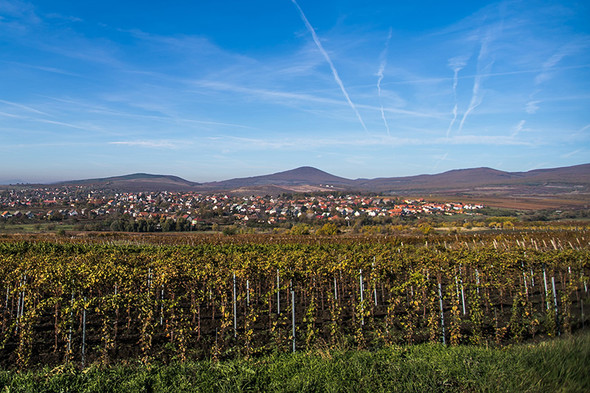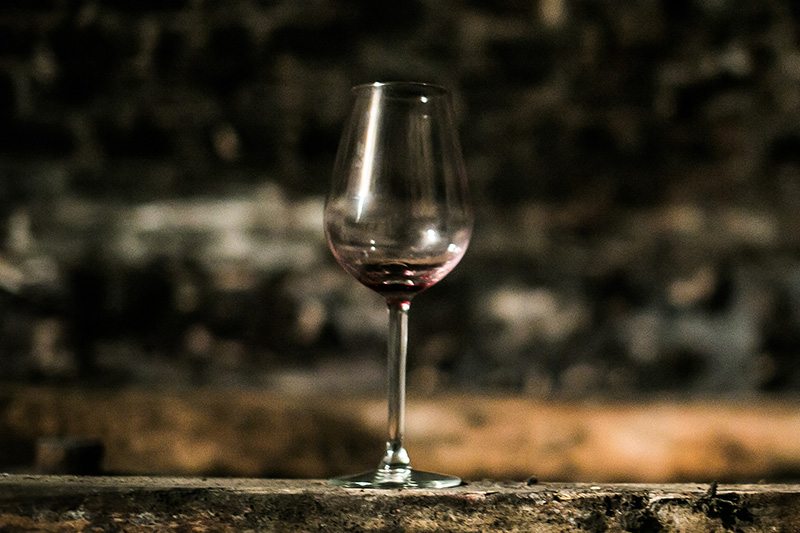The Mátrai wine-growing region lies on the foothills of the Mátra mountain range in northern Hungary and covers nearly 7600 hectares. Its vineyards are protected from the cold from the north by the mountains, whose highest peaks reach to just over 1000 metres, resulting in hot summers and mild winters. Vineyards start on the lower plains but the better vineyards lie on the lower slopes of the mountains, dominated by the higher peaks. Sárhegy, the high, south-facing hillside (part of it is the highest vineyard plateau in Hungary) is where the best wines, some 30% of the production, come from.
Under Communism, it was organised so that red wine was produced in Eger and white wine in Mátra. After the fall of Communism, the market for the white wines collapsed and the region had to adapt. This they managed in two ways. Some former vineyards were transformed into major nurseries for grafting vines. For the rest, high volume white wine was made and exported. For most foreigners, myself included, our knowledge of Mátra is good, cheap entry level white wine, softly aromatic with fresh acidity.
This has meant that Mátra has usually been excluded from wine trips in Hungary, and this was to be my first visit to the region. I received mixed comments from friends and colleagues. Most people asked ‘Why are you going to Mátra?’ But a few people alerted me to the fact that there were some exciting things happening in the region. I was visiting to taste the top of the range wines and a tasting at the Mátra Lifestyle Hotel was organised with some twenty odd producers who had brought a few bottles each and presented 49 wines ranging from fresh aromatic, through rosé to red wines.
Here are my favourites.
Olaszrizlings from Molnár, Maróti and Pálinkás showed exactly what this variety can achieve. Perfumed, spicy, floral and fruity, great intensity of weight and flavours all backed by beautiful acidity.
A range of fresh green gooseberry and elderflower wines included Kardos-Kiss’s ‘Zsendülés’ Zenit full of elderflower and gooseberry freshness and three Sauvignon Blancs from Dubicz 1014, Molnár and Bárdos which showed fresh gooseberry, grass and creamy ripeness on the first two and more floral creamy peach fruit on the last.
A lone Tramini from Kardos-Kiss, was beautifully fragrant with roses and rose water with a long restrained and elegantly dry finish.
Two Pinot Gris, one from Babiczki and one from Csernyik Nyitány, both showing rich dried apricot fruit and crisp acidity.
Two late harvest wines. Pinot Gris from Pálinkás, which was very different, having benefitted from the long hot summer to produce an off-dry late harvest wine. Dubicz’s Late Harvest Hárslevelű, semi-dry at 12g/l was beautifully rich with beeswax, honey, rich, mineral, sweet honey and lovely savoury stoney acidity.
The most successful dry oaked wine was Babiczki’s oaked Chardonnay which retained enough good acidity to carry the rich full fruit. Intense, complex flavours of herbs, lemon and toffee - delicious.
The one Riesling from Kerekes showed good intensity and flavour with long citrus acidity and a lovely intensity of ripe mineral fruit and good elegance.
Furmint and Hárslevelű, better known in the making of Tokaj and usually linked with volcanic regions, also showed well. H2’s Furmint was salty, mineral, savoury and intense. Csernyik Nyitány’s blend based on Hárslevelű was dry, salty and lemony with the floral charm of the Hárslevelű; Centurio’s Hárslevelű was full of lime, citrus, candied lemon peel and mineral acidity.
My four favourite rosés, made with Kékfrankos, from Molnár, Centurio’s ‘Első Fejtés’, Csernyik Nyitány and Ákos Pince Nyárest all showed excellent fresh fruit character, good acidity with lovely dry mineral restraint. There was one rosé oddball, which I also liked, a Pinot Gris from Losconci. Fermented on the skins, it was a dark red rosé made from white grapes.
Zweigelt and Kékfrankos also showed well amongst the reds. Ákos Pince Kámélus Zweigelt was full of fresh raspberries, firm minerality, chewy acidity and good weighty structure. The range of Kékfrankos reds showed just how versatile this variety can be. From H2’s vibrant summer red full of juicy berry fruit and fresh acidity; Kerekes’s spicy, floral, fresh red fruit; Centurio’s ripe and spicy style with firm tannins to Maróti’s big black intense inky wine with a long salty mineral finish.
And finally, two Cabernet Francs which showed just how elegant and fresh this variety can be when handled well. Babiczki’s ‘Solymosi’ full of violets, black fruit and fresh, vibrant acidity and elegant tannins and Nyilas’s more mature floral and black fruit wine with savoury, gamey, chewy tannins and long fresh acidity.
In conclusion, I finished the tasting excited by the range and quality of the wines available, of the potential of the region and keen to return to discover more. A big thank you to the producers of Mátra for such a splendid tasting.







